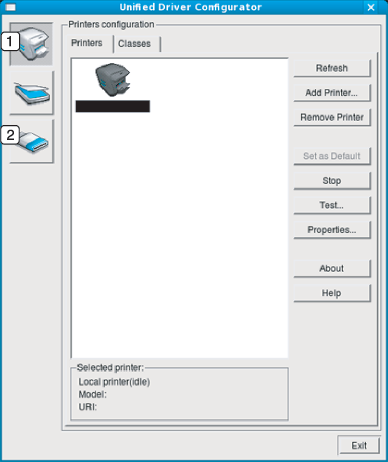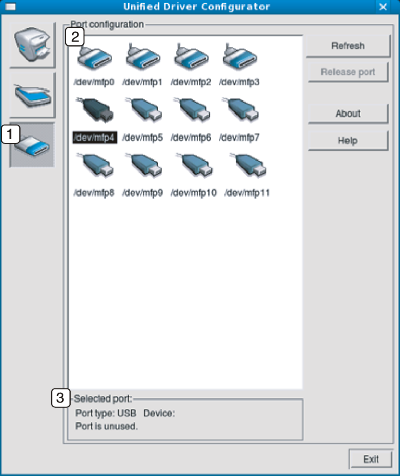The Unified Driver Configurator is a tool primarily intended for configuring machine devices. You need to install Unified Linux Driver to use Unified Driver Configurator (see Installation for Linux).
After the driver is installed on your Linux system, the Unified Driver Configurator icon will automatically be created on your desktop.
Opening Unified Driver Configurator
-
Double-click the on the desktop.
You can also click the Menu icon and select > .
-
Click each button on the left to switch to the corresponding configuration window.

![[Note]](../../common/icon_note.png)
To use the on screen help, the or
 button
from the window.
button
from the window. -
-
After changing the configurations, click to close the .
Printers configuration
has the two tabs: and .
tab
View the current system’s printer configuration by clicking on the machine icon button on the left side of the window.

|
1 |
Switches to . |
|
2 |
Shows all of the installed machines. |
|
3 |
Shows the status, model name, and URI of your machine. |
The printer control buttons are, as follows:
-
: Renews the available machines list.
-
: Allows you to add a new machines.
-
: Removes the selected machine.
-
: Sets the current selected machine as a default machine.
-
: Stops/starts the machine.
-
: Allows you to print a test page to ensure the machine is working properly.
-
: Allows you to view and change the printer’s properties.
tab
The Classes tab shows a list of available machine classes.

|
1 |
Shows all of the machine classes. |
|
2 |
Shows the status of the class and the number of machines in the class. |
-
: Renews the classes list.
-
: Allows you to add a new machine class.
-
: Removes the selected machine class.
In this window, you can view the list of available ports, check the status of each port and release a port that is stalled in a busy state when its owner has terminated the job for any reason.

|
1 |
Switches to . |
|
2 |
Shows all of the available ports. |
|
3 |
Shows the port type, device connected to the port, and status. |
-
: Renews the available ports list.
-
: Releases the selected port.